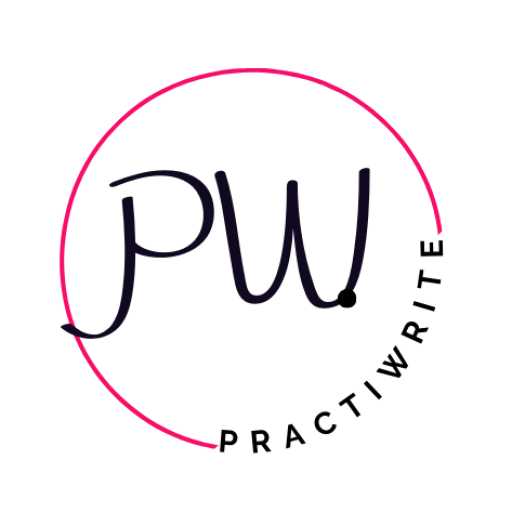It’s 7:46 a.m.
You haven’t had coffee.
Someone just cracked a molar on a granola bar and is blowing up your phones.
They’re in pain.
They’re panicked.
They’ve got no idea you’re fee-for-service now.
And all they want to know is: “Do you take my insurance?”
Welcome to emergency dental care in a fee-for-service practice, where sticker shock, no-shows, and “I’ll call you back” are waiting to wreck your schedule and your profitability if you don’t have a system in place.
Most FFS offices either:
- Panic and start giving away care just to be the hero, or
- Over-explain the out-of-network stuff and scare the patient off before they even sit down
Neither of those is a strategy.
But there is one and it starts with protecting your schedule, setting expectations fast, and charging appropriately for high-value, high-pressure emergency care.
Let’s break down how to handle same-day visits, referrals, and the occasional walk-in train wreck like the calm, confident, profitable practice you’re building.
Not like you’re still operating under PPO panic mode.
Table of Contents
How To Handle Emergency Dental Care In A Fee-For-Service Practice
Emergencies in an FFS Model Must Be Structured, Not Reactionary. If you’re still handling emergency patients with “just squeeze them in,” you’re killing your production and confusing your team.
Emergency care in a fee-for-service model can drive serious revenue, but only if your time, pricing, and messaging are protected by a real system.
The Fastest Way to Lose Money? Play Hero Without a Plan
Here’s the typical scene in most offices post-PPO:
- A patient calls with pain
- The front desk tries to “make it work”
- You move mountains to treat them between scheduled patients
- They ghost you after getting relief and never pay full freight
No follow-up.
No retention.
No margin.
Just chaos.
That’s not emergency dentistry. That’s running an urgent care with no triage, no billing process, and no boundaries.
And in a fee-for-service model? That’s a slow leak in your profitability every single day.
System = Calm, Profitable, Repeatable
Want to stop resenting emergency visits?
You need structure. And it starts with three non-negotiables:
- Pre-blocked emergency time
- Clear, out-of-network pricing
- A front desk trained to screen, quote, and collect with confidence
Let’s break those down.
1. Block Emergency Time Like It’s a VIP Spot
You shouldn’t be squeezing emergencies into lunch breaks or begging your hygienist to move things around.
Set up dedicated emergency slots in your schedule just like you would for consults or high-value treatment.
- 30 to 60 minutes per day, preferably mid-morning or late afternoon
- Label it clearly in your software (e.g., “Emergency Flex” or “Same-Day Access”)
- Assign a specific room and assistant if possible
This creates:
- Less disruption for your team
- More predictability for your production
- Faster access for patients in pain (who often turn into long-term loyalists if handled right)
And if no emergency comes in? You’ve got time for same-day follow-ups, overdue treatment, or catch-up production.
2. Flat-Fee Emergency Visits Beat “We’ll See What It Costs” Every Time
Most FFS patients don’t care about insurance lingo. They just want to know what they’re walking into.
Instead of throwing random treatment codes at them mid-visit, offer a clear, flat-fee emergency package.
Example:
$299 Emergency Visit Includes:
- Limited exam
- 1 PA x-ray
- Palliative treatment (e.g., smoothing, antibiotics, temp filling)
This is what top-performing practices are doing and it works. According to Dental Intelligence, same-day emergency visits have a 68% higher case acceptance rate when fees are discussed before the patient arrives.
You can always upsell definitive treatment after the fact. But clarity up front = trust, speed, and payment.
3. Train Your Front Desk to Triage Like Pros, Not People-Pleasers
Your admin team sets the tone for the entire visit.
Here’s a basic triage call flow they should follow for every emergency call:
- Ask About Symptoms: “Are you in pain right now?” “How long has this been going on?”
- Qualify Fit: “We’re a fee-for-service office, which means we’re out-of-network with insurance, but we help patients use their benefits every day. Does that work for you?”
- Quote Flat Fee: “Today’s emergency visit is $299, and it includes your exam, x-ray, and palliative care.”
- Secure the Appointment: “We have a slot at 10:30 this morning. We’ll send your forms to fill out now so we can get you seen quickly.”
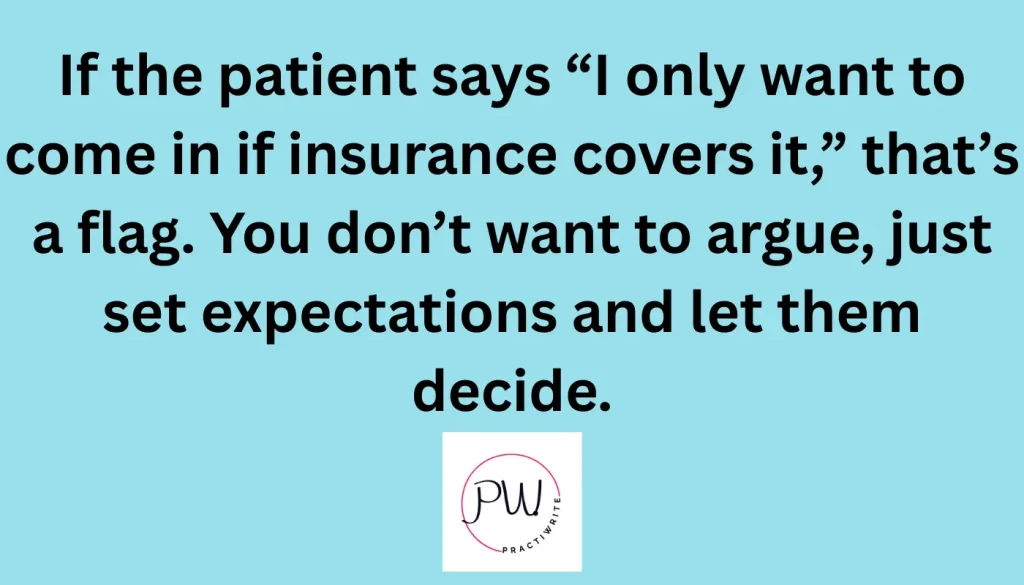
Emergency care can be one of the most profitable services in your FFS model, if you treat it like a system, not a surprise.
Pricing Emergency Care When You’re Out of Network
Emergency visits are high-value, high-trust opportunities, not loss leaders.
In an FFS model, you need pricing that’s easy to quote, profitable for your time, and transparent enough to convert stressed-out patients into paying ones. Flat fees win.
Flat Fees Make It Easy for Patients and Profitable for You
Out-of-network patients are already nervous.
If your front desk can’t give them a straight answer on what they’ll pay, they’ll either:
- Bail before booking
- Show up angry
- Leave without accepting care
Flat fees take the pressure off everyone and they’re the gold standard in FFS emergency care.
Here’s a sample:
Emergency Visit Package: $299
Includes:
- Limited oral exam
- 1–2 x-rays
- Palliative treatment (smoothing, drainage, temp filling, antibiotics if needed)
It’s simple. It’s predictable. And it lets the patient focus on getting relief, not negotiating a treatment plan from the chair.
Practices that use flat-fee emergency pricing report 25–30% higher patient retention from emergency visits compared to those who bill everything à la carte.
Need to Go À La Carte? Use a Script and a Printout
There are still scenarios where flat fees don’t fit, like surgical cases or patients mid-treatment.
If you go à la carte, here’s the minimum your team should prep in advance:
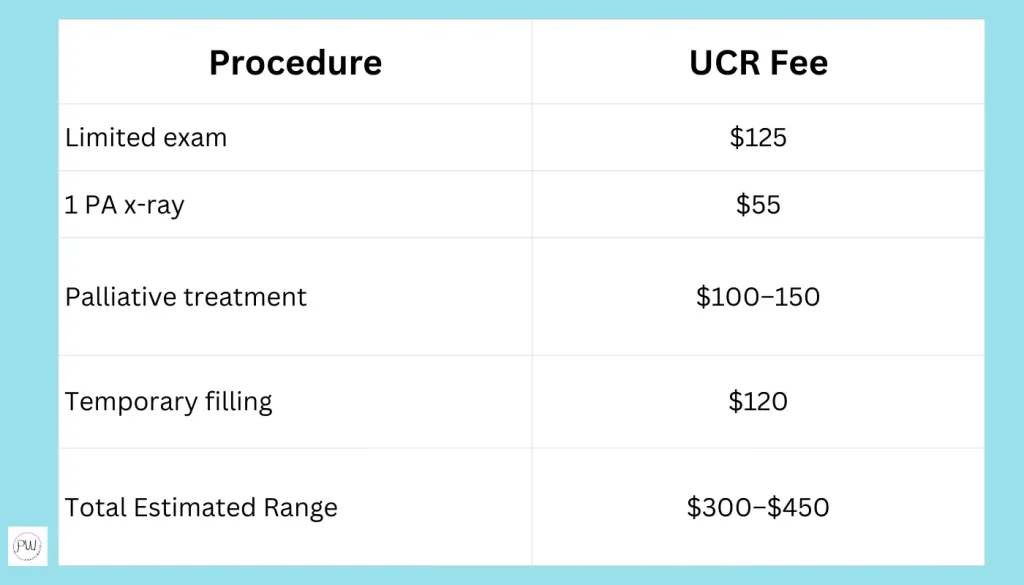
Then give patients a script like:
“Based on your symptoms, today’s visit will likely include an exam, an x-ray, and relief care. That typically ranges between $300 and $450, depending on what we find. We’ll confirm everything before starting.”
You can even create a laminated or digital “Today’s Visit Estimate” sheet for emergencies. Hand it to the patient before they’re numbed. Transparency builds trust and trust builds treatment acceptance.
Don’t Discount. Offer Clarity Instead.
The worst move you can make? Offering a discount because the patient seems upset about being out-of-network.
You’re not running a charity. You’re running a high-value, independent practice.
Here’s what to say instead:
“We’re out-of-network, which means we don’t take assignment of benefits. But most of our patients are still able to use their insurance and get reimbursed directly and we’ll help with that.”
Pair that with:
- A printed claim form (pre-filled)
- A resource like Reimbursify or Anagram
- Optional: Membership plan info for long-term savings
And boom, you’ve replaced panic with a path forward.
Scheduling Protocols That Keep Emergencies From Wrecking Your Day
Emergencies are unpredictable, but how you handle them shouldn’t be. Protect your production by building buffer time into your schedule, creating triage rules, and training your team to say “yes” without blowing up your day.
Build In Emergency Flex Time (or Emergencies Will Steal It Anyway)
You’re already seeing emergencies.
The question is: Are you in control of them or are they in control of you?
If you’re just “working them in,” here’s what’s really happening:
- Your assistant is flustered
- Your scheduled patient is waiting
- Your emergency patient is frustrated
- Your production for the hour just went out the window
Fix it with a simple system:
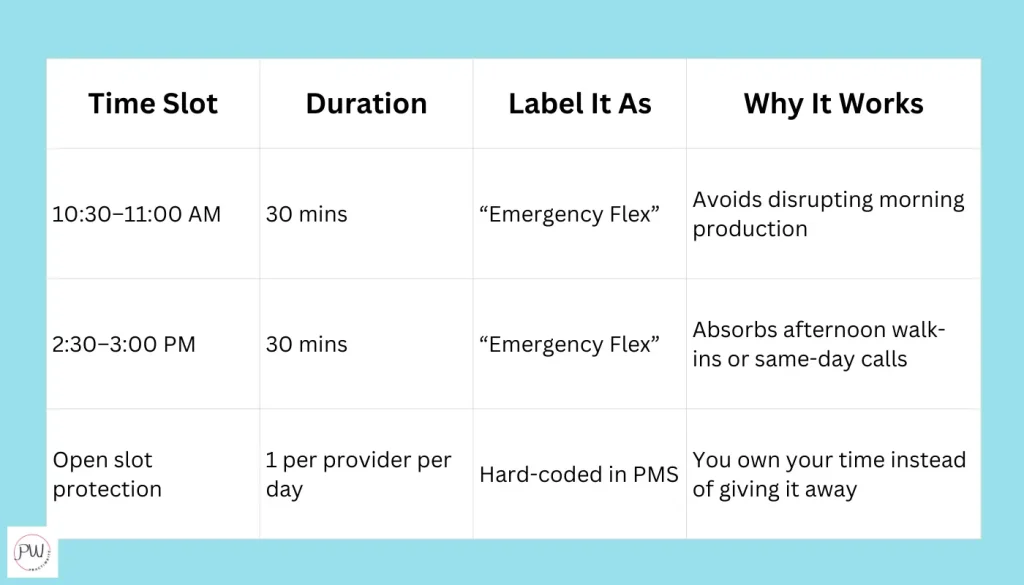
And no, this isn’t “wasted” time if no one calls. You can always use it for:
- Same-day treatment
- Overdue work
- Team catch-up
- Diagnostics
It’s not downtime. It’s strategic white space.
Create a “Rapid Response” System for Your Team
Emergencies shouldn’t require a team huddle.
You need a protocol your staff can run automatically.
Here’s what it includes:
- Emergency Triage Form (digital or clipboard):
- Chief complaint
- Pain scale (1–10)
- Onset and duration
- Any visible swelling or trauma
- Current medications
- Chief complaint
- Appointment Type Code:
- Use a separate code in your software (e.g., “ER-FFS”) to flag it and track production
- Use a separate code in your software (e.g., “ER-FFS”) to flag it and track production
- Preloaded Treatment Room:
- Have a basic emergency tray ready to go: exam, PA setup, temp filling material, anesthetic
- Have a basic emergency tray ready to go: exam, PA setup, temp filling material, anesthetic
- Pre-appointment communication:
- Text or email a short intake + payment form as soon as they’re booked
- Text or email a short intake + payment form as soon as they’re booked
You’re not just being efficient. You’re creating a premium emergency experience and charging accordingly.
Enforce a No-Show & Late Cancel Policy. Even for Emergencies
Not every “emergency” is urgent. Not every emergency patient is worth the disruption.
If you’re FFS, time is money. Flaky patients cost both.
Create a written emergency policy that includes:
- A fee for missed emergency appointments
- A requirement for prepayment or deposit for new patients
- A friendly-but-firm script for enforcement
Example script:
“Because we reserve special time in our schedule for emergency care, we do require 24 hours’ notice for cancellations or a $50 fee will apply. For new patients, we do collect the $299 emergency visit fee in advance to reserve the time. Sound good?”
This isn’t rude. It’s professional boundaries. Patients respect them when delivered with confidence.
What to Do When Emergency Patients Ask About Insurance
You’re going to get this question, every time. In a fee-for-service office, the win isn’t being “in-network.”
It’s being in control.
Train your team to answer confidently, set expectations early, and turn insurance confusion into treatment clarity.
First Rule: Don’t Flinch
You’re not doing anything wrong by being out-of-network.
If your team reacts with hesitation or starts over-explaining, the patient picks up on that and now they’re suspicious, even if they were fine five seconds ago.
Instead, own it. Here’s a go-to script that works:
“We’re not in-network with any insurance providers, which means we don’t take assignment of benefits. But most of our patients still use their benefits here. We’ll help you get reimbursed, and we can walk you through exactly what to expect.”
Boom.
Confidence.
Clarity.
Zero apologies.
Second Rule: Have a System, Not a Shrug
Don’t leave it at, “You can submit it yourself.” That’s the lazy out.
Instead, set your office up to actually support the reimbursement process. You don’t have to become an insurance expert. But you should give patients what they need to get their money back.
Here’s your bare-minimum FFS insurance toolkit:
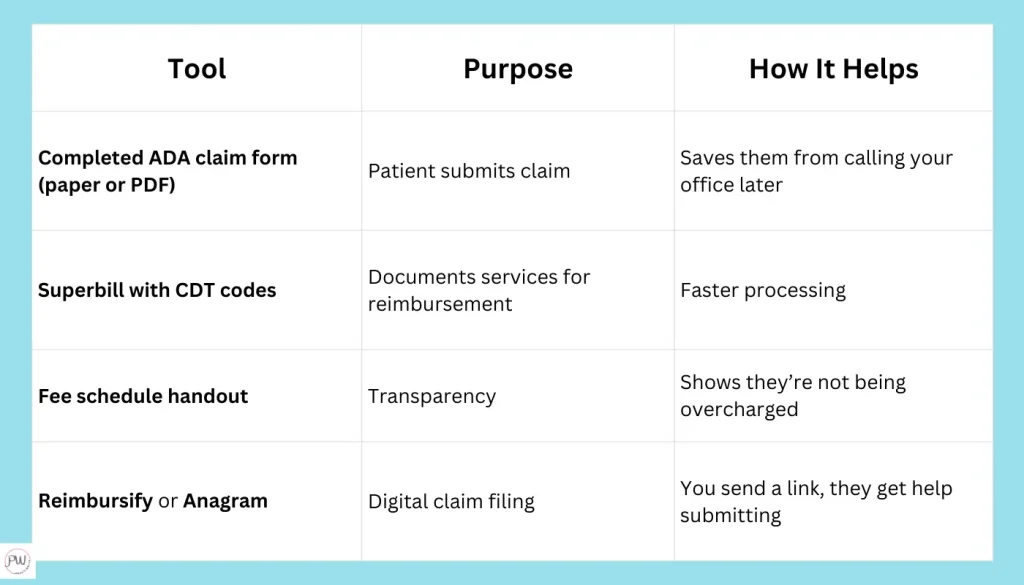
Third Rule: Default to Value, Not Discounts
This is where some practices panic and start making up discounts on the fly:
“Uhhh… we can probably knock off 10% since you’re paying out of pocket…”
Don’t.
That’s not value. That’s financial insecurity.
Instead, redirect the conversation to the care they’re getting:
“Our focus is getting you out of pain today, fast, with no surprise billing, no waiting for approvals, and no restrictions. We’ll show you exactly what your visit includes and what it costs before we start.”
And if you’ve got a membership plan? Now’s the perfect time to mention it.
“A lot of patients who don’t have dental coverage end up joining our in-house plan after their emergency visit. It includes cleanings, exams, and discounts on future treatment. We’ll send you the details after today.”
This turns a one-time visit into long-term revenue without ever negotiating your worth.
Emergency Patient → Long-Term Patient: Yes, It’s Possible
That emergency patient isn’t just a one-off. If you play it right, they’ll come back (again and again) and they’ll refer. The key is what you do after the exam.
Most practices drop the ball. You won’t.
Follow-Up = The Loyalty Engine Nobody Uses
You got them out of pain. Good job.
Now most offices… just wait.
No text.
No call.
No next steps.
Just silence. Then that emergency patient floats off to the next office that takes their insurance.
Fix it with one simple move: Call or text the next day. Seriously.
Here’s the script:
“Hi [First Name], this is [Your Name] from [Your Practice]. Just checking in to see how you’re feeling after your visit yesterday. Let us know if you need anything and if you’d like help scheduling a follow-up, we’re here.”
This one touchpoint turns:
- Panic into trust
- A transaction into a relationship
- A maybe into a yes
Stat To Back This Up: Patients who receive a same-day or next-day follow-up are 72% more likely to return for additional care, according to Dental Intelligence.
Use Emergencies to Introduce Your FFS Model, Not Apologize for It
Most FFS offices treat the emergency patient like they’re still in a PPO office.
They apologize for pricing.
They don’t explain what’s different.
They make it awkward.
Don’t do that.
This is your moment to explain, confidently, why your practice is better and worth it.
“We’ve stepped out of the insurance network system so we can treat patients without restrictions, delays, or approvals. You get more time with the doctor, clearer pricing, and better care. And most of our patients tell us it’s a major upgrade.”
Then? Show them the path forward:
- Offer your membership plan right after treatment
- Present any next steps clearly: “Here’s what we recommend next…”
- Book the next visit before they leave
It’s not a sales pitch. It’s continuity.
And patients crave it, especially after being in crisis mode.
Bonus Play: Offer a “We’ve Got You” Packet
Make it easy for them to stay with you by giving them a take-home folder or digital follow-up that includes:
- Your treatment plan summary
- A simple breakdown of today’s visit and cost
- Info on your membership plan
- How to file insurance for reimbursement
- A thank-you note (even automated is fine)
It’s a premium experience that matches your premium model.
And it makes a one-time visit feel like an intentional relationship, not a dental drive-thru.
Referral Networks in FFS: How to Build Them Without Insurance Contracts
Just because you’re out-of-network doesn’t mean you’re out of the loop. In fact, you now get to refer (and receive) based on quality, not contracted rates.
But it takes intention. You need to build an FFS-aligned referral network the same way you’d build a treatment protocol: deliberately.
Stop Referring Based on PPOs. Start Referring Based on Alignment.
Back in your PPO days, referrals were easy:
- Find a name on the insurance list
- Fax over the treatment notes
- Hope they don’t screw it up
Now? That’s not good enough.
You’re fee-for-service now. Your patients are paying out of pocket, and your reputation is on the line every time you refer out.
So it’s time to ask:
- Does this specialist treat patients like I do?
- Are they fee-for-service, concierge, or just PPO in disguise?
- Do they understand the expectations of my patient base?
Don’t build a referral list based on convenience. Build it based on consistency of experience.
Start with:
- Periodontists who offer patient-friendly payment options
- Oral surgeons who prioritize same-day consults or availability
- Endodontists who actually communicate (yes, they exist)
- Cosmetic labs that match your quality, not your discounts
Create a “Pro-to-Pro” Referral Experience That Feels Premium
Want to get more referrals from other high-quality GPs or specialists? Don’t just send a patient and cross your fingers.
Build a system for outbound and inbound referrals that makes other docs say, “Damn, this practice has it together.”
Here’s your mini FFS Referral Framework:
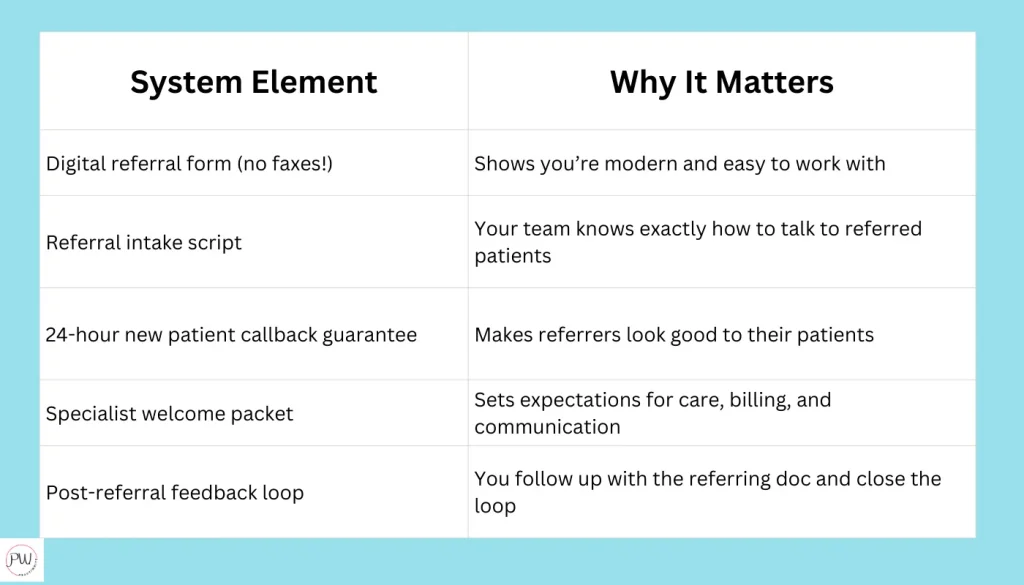
Make it easy, fast, and professional. That’s how you become the preferred FFS provider in your area.
Yes, You Can Get Referrals From In-Network Providers
Being out-of-network doesn’t mean other offices won’t refer to you.
If you’re:
- Known for handling tough cases
- Willing to see emergencies quickly
- Transparent with your pricing
- Excellent with follow-up…
…you will get referrals even from in-network dentists.
Because most PPO offices are drowning. They’re happy to send patients your way when they can’t fit them in.
Specialists love FFS General Practices who don’t send patients with a $5 co-pay mindset.
Your patients value care.
That makes you valuable.
Build Relationships Like It’s 1995 (Because It Works)
If you want to grow your referral base, go analog:
- Drop off handwritten thank-you notes
- Invite your top referrers to a local CE dinner
- Shout out great specialists on social media
- Host a joint event for shared patients (orthodontist + GP, etc.)
Referral growth in FFS isn’t transactional. It’s relational.
Treat your referral partners like VIP patients, and they’ll do the same for you.
Technology That Helps You Handle Emergencies Smoothly
Same-day care doesn’t have to feel like a fire drill. With the right tech stack, you can book, screen, treat, and follow up on emergency visits faster, without burning out your team or losing track of billing.
This isn’t just convenience. It’s profitability.
Online Scheduling = Fewer Phone Calls, Faster Conversions
When someone’s in pain, they don’t want to wait on hold while your front desk navigates openings between hygiene checks.
Let them book their own emergency visit right from your website.
Top tools:
- NexHealth: Real-time, EHR-integrated online booking
- LocalMed: Specializes in dental + same-day availability
- YAPI: Adds automated confirmations + new patient forms
Set aside 1–2 “Emergency Visit” slots in your schedule and mark them as bookable online for new patients only. This is a game-changer for visibility and conversions.
Paperless Intake = 10 Minutes Saved Per Patient
Every minute counts in a packed schedule. Paper forms? Total bottleneck.
Use paperless, pre-visit intake forms that:
- Auto-fill into your software
- Pre-authorize payment
- Include emergency-specific triage questions
Best tools:
- Modento: HIPAA-compliant, branded digital forms
- Mango Voice + Forms: Integrated forms + VoIP
- Jotform HIPAA: DIY but flexible
Set it up so patients complete everything before arrival, especially for emergency slots. You’re not just saving time. You’re pre-framing the visit as structured and professional.
Texting > Phone Tag, Every Time
You’re not going to get someone in pain to check their voicemail and call back. Two-way texting is your emergency superpower.
Use texting to:
- Confirm appointments
- Send directions and intake links
- Follow up post-visit
- Share cost estimates or forms
Tools like:
- Weave
- Simplifeye
- Doctible
These platforms also support auto-replies, so if someone texts at 9pm, they still feel taken care of, even before your team is back in the office.
Billing + Payment Collection Tools That Don’t Slow You Down
If you’re printing receipts and explaining codes chairside, you’re slowing your team down.
Use platforms that let patients:
- Pay by text or email
- See a clear breakdown of charges
- Get receipts automatically
- Even enroll in membership plans post-visit
Best tools:
- Rectangle Health: Payment processing + recurring billing
- Clear: Patient-facing membership and pricing tool
- Swell: Patient communication + payment experience combo
These tools also feed into your case acceptance workflows, so you can immediately follow up with treatment plans after pain relief is handled.
Bonus: Add a “Mini CRM” for Emergency Follow-Up
Want to convert more one-time emergencies into full-time patients?
Track them.
Use a simple CRM or patient reactivation tool to:
- Tag emergency-only visits
- Schedule a follow-up call or reactivation campaign
- Send a “Thanks for trusting us” text + membership plan link
Lightweight tools like:
- Lasso MD
- Dental Intelligence Engagement
- Patient Prism: Also helps coach phone calls + track conversions
If you don’t follow up, you’re leaking potential. These tech tools help you lock in loyalty before they Google “dentist near me” again.
Checklist: Is Your Emergency System FFS-Ready?
Here’s a fast gut check:
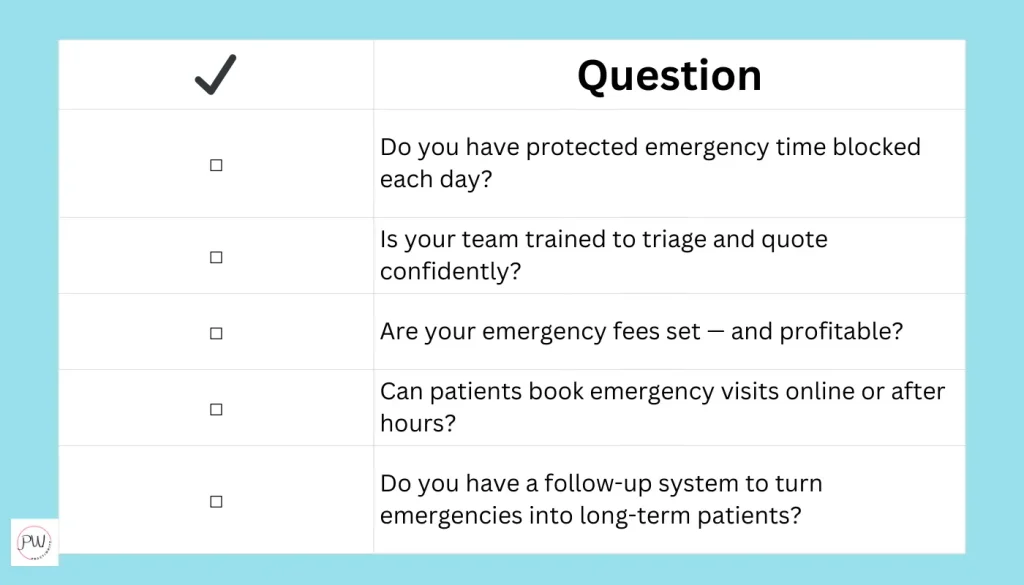
If you checked fewer than 4 boxes? You’re leaving money, trust, and case acceptance on the table.
Good news: It’s all fixable.
And you don’t need to reinvent your whole practice. Just install a smart system that makes emergency care easier for your team, clearer for your patients, and more profitable for your bottom line.
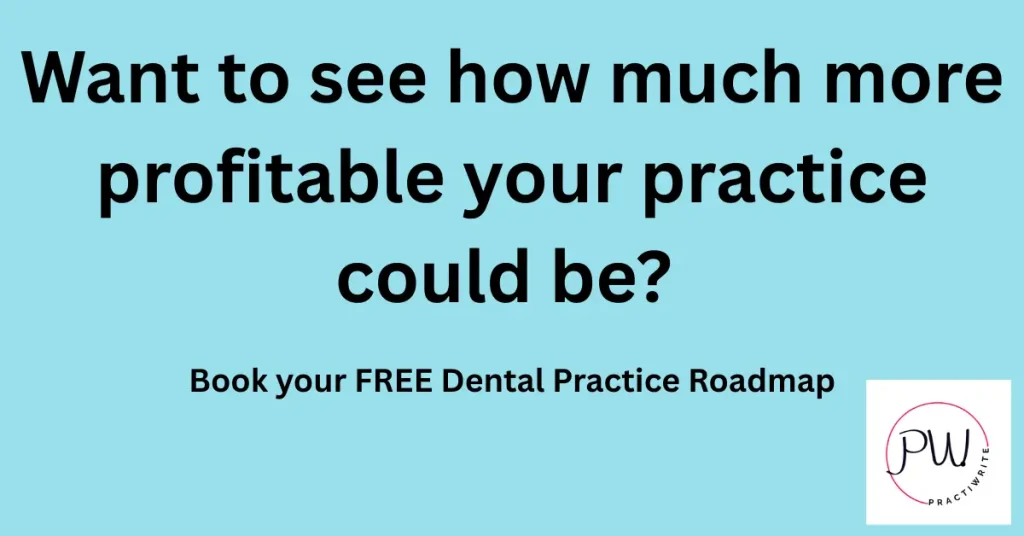
A Final Word: Don’t Panic. Just Systematize.
Emergency visits aren’t the problem. Lack of structure is.
With a clear system, transparent pricing, and the right tech, your fee-for-service office can turn chaos into consistency….and one-off toothaches into long-term, high-value patients.
Your Next Move
Learn where your practice stands now AND how to get where you want to be.
You’ll find out how proper SEO (that’s optimized locally and for LLMs like ChatGPT) will impact your practice.
Book your free strategy call now.
Let’s make sure your next move is your smartest one yet.
10+ year content strategist, writer, author, and SEO consultant. I work exclusively with dental practices that want to grow and dominate their local areas.
